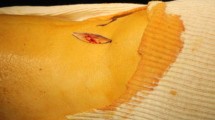Abstract
In 12 human cadaver tibiae, osteotomies were carried out at two levels (2 and 3 cm from the distal joint line) with three different wedges (5°, 10°, 15°) to evaluate the influence of displacement of the osteotomy fragments on areas of cortical contact. In undisplaced osteotomies (medical cortical edges superposed) cortical contact areas formed 28% (level 2 cm) and 40.5% (level 3 cm) of the cortical circumference of the proximal fragments (NS). Wedge angles and levels of osteotomy displayed no statistical differences. In displaced osteotomies cortical contact decreased significantly (P < 0.05). Displacing the distal fragment laterally, medial cortical contact is lost, and weight-bearing leads to revarisation as cancellous bone sustains only 3 MPa, and the measured compressive stresses at the medial edge amounted to 6 MPa on average. Displacing the distal fragment medially leads to a decrease of total cortical contact, too, but at the medial edge of the osteotomy cortical contact areas are still present. As a result of the study, postoperative weight-bearing without additional plaster cast fixation is recommended only in cases with undisplaced fragments.
Similar content being viewed by others
Author information
Authors and Affiliations
Additional information
Received: 29 December 1997
Rights and permissions
About this article
Cite this article
Böhler, M., Fuss, F., Schachinger, W. et al. Loss of correction after lateral closing wedge high tibial osteotomy – a human cadaver study. Arch Orth Traum Surg 119, 232–235 (1999). https://doi.org/10.1007/s004020050399
Issue Date:
DOI: https://doi.org/10.1007/s004020050399




